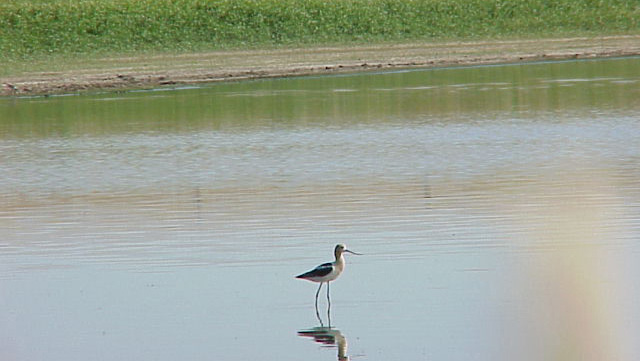Looking through binoculars or a spotting scope at one of the ponds on open space you might see a distinctive bird strolling on slender bluish-gray legs. Its nickname is “blue shanks,” but the more commonly used name for this bird is American avocet.
It’s easy to spot these birds, but still a treat when one appears in your view. The American avocet is medium-sized – 18 to 20 inches tall. This bird’s body has a distinctive, black and white striped pattern on its posterior and flanks, while the abdomen and underbelly are white.
The long beak, one if its defining features, is what gives the American avocet its scientific name, Recurvirostra americana. In Latin, “recurv” means upcurved, and “rostrum” means “beak of a bird” which comes from the word for a prow of ancient Roman ships.
Generally, American avocets will search for their meal of aquatic plant life and animals such as insects and crustaceans using a sweeping motion of their bills, but they are also known to probe into mud in search of food. Additionally, these birds will venture into deeper water and dabble much like a duck would. American avocets commonly feed solitarily but may feed in flocks – a line of birds advancing abreast.
A year in the life of an American avocet begins and ends with migration. Northbound migration occurs from March to May. American avocets prefer open water and marshy spring and summer habitats such as lakes and ponds throughout the central plains of the United States, including the Rocky Mountain region and southern Alberta and Saskatchewan. Some nonbreeding one-year-olds return to the breeding grounds where they hatched in the spring.
American avocets are monogamous birds that find mates in the springtime through elaborate courtship behavior. In his pre-copulation display, the male preens himself with water, gradually gaining intensity to the point of frenzied splashing just before he mounts the female. After copulating, the pair intertwines their necks and runs forward in an elaborate, ritualized display of territory establishment and self-defense.
A Simple Home
These birds nest in colonies from April to June. Nest construction consists of creating mere depressions on the sand, platforms on mudflats or a scrape on the ground. Occasionally, the nest will be lined with grass or other vegetation, feathers, pebbles or other small objects, but generally the nest is unlined as if the bird sees covering the ground as wasted motion. Should the water level rise, the breeding pair will raise the nest up a foot or more with sticks, weeds, bones and feathers to keep the eggs above water.
A female will have three to four eggs during the nesting season. The parents take turns incubating the eggs for 23 to 29 days. Parasitism is rather common in avocet communities. Eggs of other wetland species such as black-necked stilts and common terns are often found in American avocet nests. American avocets will lay their eggs in the nest of another American avocet or other species of wetland birds. The precocial, downy young can leave the nest soon after hatching with the ability to run, swim and feed themselves. Both parents will tend the chicks for 28 to 35 days after hatching until they learn to fly.
When threatened, an American avocet can be aggressive, especially near nesting areas. One dramatic anti-predator display is a dive-bombing action. One or more birds swoop down on intruders, performing a synchronized aerial mobbing attack, narrowly missing the predator. Another territorial protection these birds perform is advancing in a teetering gait, as if on a tightrope, toward the approaching terrestrial predator, with wings outstretched spanning 28 to 36 inches. Further displays include high-piercing “keeek-keeek-keeek” cries of displeasure, acting as if crippled, crouching as if incubating, then moving to crouch in a new location, and a begging-for-pity performance.
Where to Look
If you have never seen an American avocet, you’ll likely see them at Walden Ponds Wildlife Habitat and Stearns Lake at Carolyn Holmberg Preserve at Rock Creek Farm this spring.



